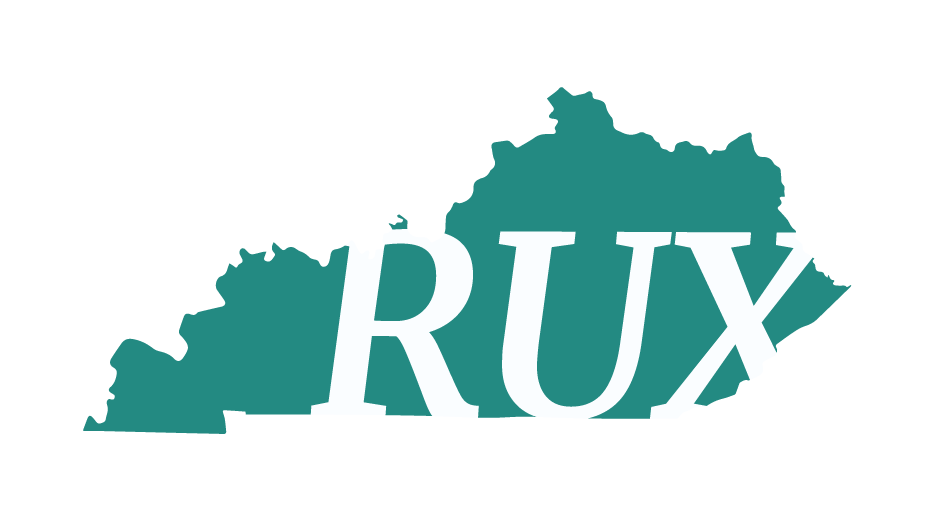Learning about Kentucky fibers at Yeiser Art Center in Paducah
All members of the 2023 RUX cohort, Michelle Amos (The Little Loomhouse), Robin Verson (Hill & Hollow Farm), and Lexie Millikan (Yeiser Art Center) share their individual and collective expertise & experience in the field of textiles.
Promotional graphics for the Kentucky Fibers events.
By hosting two distinct events over the course of the weekend, multiple goals were met. There was a free public workshop that anyone could attend. This was an important element for the facilitators as they believe that art should be accessible to the community. There was also a ticketed workshop, which helped support the host location, and included a discount for members of the three facilitators’ organizations.
Folks gather at Yeiser Art Center to learn about Kentucky textile traditions.
Saturday’s free public artist talk covered many textile topics including the history of natural dyes, spinning, state weaving history, connections between farming and fiber, and much more.
Handmade yarns at the workshop.
Michelle brought a Little Loomhouse publication, Some Historic Kentucky Coverlets and Robin brought her handmade zine, A Mini Guide to Plant Dyes, for visitors to the artist talk and workshop.
Publications brought by the organizers.
During the artist talk.
During the artist talk, each of the facilitators spent time talking about their own work and inspiration from Kentucky and other sources. Michelle shared a brief history of the Little Loomhouse founder, Lou Tate, and the loom that she invented. She also discussed the history of Kentucky coverlets, the fact that Kentucky artists are underrepresented in the national dialogue, a description of drafts and how those function in weaving, and how her own artwork was influenced by historical weavings. An important point that Michelle made was that although the weaving of coverlets was known to be happening in the Eastern part of the state, it was actually a more widespread practice. The coverlet was functional but also became an art form meant to showcase the weaver’s skill.
Robin discussed her work as an organic farmer who originally raised vegetables, but in looking at the whole farm organism, eventually started raising livestock in order to nourish the soil and plants. This is where her journey with raising wool began. She started with a heritage breed that had beautiful wool that didn’t need to be dyed. Eventually, she expanded the flock to include a white sheep that would lend itself to plant dyes. Robin became obsessed with the idea of local agriculture including not only food that could be grown in Kentucky but also plant dyes. In Robin’s words, “The tradition of color is the tradition of plant dye.” She works with indigo, goldenrod, dyer’s coreopsis, osage, walnut, and other natural dyes that can be grown on her organic farm. Her work contributes to our regional Fibershed.
Lexie introduced some of her own artwork and short history as a resident of Kentucky. She is interested in carrying on the textile traditions of her family in the form of quilting and weaving. Her interest in natural dyes started in college and has expanded since then, eventually traveling to Robin’s farm to learn about Kentucky-grown indigo. Lexie uses found fabrics and hand-dyed fabrics when creating her artwork, in an effort to recognize the history that exists in a functional garment and to also celebrate the connections to her local Fibershed through natural dyeing. She sees a natural connection in where a person’s food, garments, and fiber come from.
There is a video of the artist talk that is archived with Yeiser Art Center for online future reference.
Getting a closer look at textiles.
There was time after the artist talk for questions and one-on-one discussion, which many of the audience members participated in. They were excited to get a closer look at the available examples.
Learning about the natural dye process.
Sunday’s workshop participants learned the natural dye process and wove a small table runner in a traditional pattern, on a foot-powered loom. Beginners were welcome so no previous experience was needed, which opened the event to more people. There were ten total class participants, and this was based on the physical space available to hold the workshop. All supplies were included in the cost of the workshop, so participants didn’t need to worry about bringing anything with them. This included floor looms brought from The Little Loomhouse and yarn provided by Hill & Hollow Farm, naturally dyed with local dyes.
Getting hands-on with the yarn dyeing process.
Madeline Bela and Lexie Millikan served as workshop assistants and documentarians.
Participants learning to use the loom.
Workshop participants had enough time to experiment with naturally dyeing yarn and watercolor paper, along with weaving a small runner. Participants were excited to have access to this type of educational opportunity, and Yeiser Art Center received a lot of positive feedback and even requests for future similar programs.
The Kentucky Fibers program was promoted through social media, websites, and newsletters of Yeiser Art Center, The Little Loomhouse, Hill & Hollow Farm, and KY RUX.
Participants using the looms.
At least one workshop participant traveled to visit The Little Loomhouse, after her experience at Kentucky Fibers, which shows there is a need for and potential for exchange across the state. If we all work together, we can bridge divides in the arts.
Participants showing off their woven runners.
Michelle, Robin, and Lexie’s background in and love for textiles were the backdrop for an informative weekend at Yeiser Art Center’s historic downtown Paducah gallery.
The Kentucky Rural-Urban Exchange (RUX) Intercultural Microgrant Program launched in 2023. We are deeply grateful to the Pluralism and Civil Exchange program of the Mercatus Center at George Mason University, the National Endowment for the Arts, and the Kentucky Foundation for Women. Their support helped us launch this microgrant program and invest in our alumni network to employ the skills they’ve learned in the RUX program to the benefit of their state and local communities.











